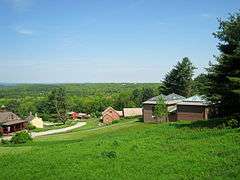Fruitlands Museum
|
Fruitlands Museum Historic District | |
|
Fruitlands Museum | |
| Location | Harvard, Massachusetts |
|---|---|
| Coordinates | 42°29′37″N 71°36′47″W / 42.49361°N 71.61306°WCoordinates: 42°29′37″N 71°36′47″W / 42.49361°N 71.61306°W |
| Built | 1910 |
| Architectural style | Shingle Style, Bungalow/Craftsman |
| NRHP Reference # | 97000439[1] |
| Added to NRHP | May 23, 1997 |
 |
| Topics |
|---|
|
| Notable people |
|
Fruitlands Museum is a cluster of small historic buildings in Harvard, Massachusetts on the former site of the unsuccessful utopian community Fruitlands. The buildings were constructed in 1910 and added to the National Register of Historic Places in 1997 as the Fruitlands Museums Historic District.
Visitors can tour the Fruitlands Farmhouse, which has been restored to appear as it did during the 1840s, and includes exhibits about Transcendentalism and the Alcott family. The Museum also includes four small gallery buildings that feature Native American, Shaker and American (Hudson River School) art. Fruitlands offers a diverse schedule of contemporary exhibits, lectures, outdoor concerts and easy walking trails. There is also a Museum Store and restaurant.
History
Fruitlands, inspired by Transcendentalism and Amos Bronson Alcott's ideas of societal reform, was established on 90 acres (360,000 m2) purchased by Charles Lane in May 1843.[2] People interested in joining the community began moving in the next month and the site was optimistically named "Fruitlands" despite having only a small cluster of apple trees. The community was based on self-sufficiency, using no hired labor and growing all the food they needed themselves.[3] The community ultimately failed because of the difficulty in growing crops. Community members began moving away as early as October 1843; Lane and Alcott abandoned it in January 1844.[4]
The property was purchased in 1910 by Clara Endicott Sears, who opened the farmhouse to the public in 1914 as a museum.[5] In addition to the Fruitlands building, the site now includes a transplanted Shaker house from the nearby Harvard Shaker Village, Native American artifacts and Hudson River School paintings.[6] The museum is primarily the result of the efforts of Sears, a preservationist.[7]
See also
References
- ↑ National Park Service (2008-04-15). "National Register Information System". National Register of Historic Places. National Park Service.
- ↑ Packer, Barbara L. The Transcendentalists. Athens, Georgia: The University of Georgia Press, 2007: 148. ISBN 978-0-8203-2958-1
- ↑ Hankins, Barry. The Second Great Awakening and the Transcendentalists. Westport, Connecticut: Greenwood Press, 2004: 36. ISBN 0-313-31848-4
- ↑ Packer, Barbara L. The Transcendentalists. Athens, Georgia: The University of Georgia Press, 2007: 149. ISBN 978-0-8203-2958-1
- ↑ Felton, R. Todd. A Journey into the Transcendentalists' New England. Berkeley, California: Roaring Forties Press, 2006: 133. ISBN 0-9766706-4-X
- ↑ Massachusetts Office of Travel and tourism - Find Lodging - Fruitlands Museum, retrieved 1 October 2008
- ↑ National Park Service - Fruitlands Museum Historic District, retrieved 1 October 2008
External links
| Wikimedia Commons has media related to Fruitlands. |
- Fruitlands Museum - official site

